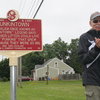School rsquo s cracked stonework to be repaired
By David S. Lewis
VOORHEESVILLE The cast-stone ornaments are cracked and deteriorating above the main entrance to Voorheesville’s elementary school, but school officials say there is no danger to the students passing underneath.
Located on the top of the school’s façade, the adornments are part of the original structure, built in the late 1920s, and the addition, built in the 1940s. They depict emblems of education, like books and the Torch of Knowledge, but, due to winter freeze-thaw cycles and improper repairs made to the school’s exterior in the eighties, the manmade rock is now falling apart.
The school is being refurbished as part of a $5.8 million bond issue passed by voters last year; school officials expect the repairs to the Art Deco façade will cost about $150,000.
According to school officials, custodians noticed last August that portions of the large stones appeared to be loose. School officials hired an engineering firm, Ryan-Biggs Associates, P.C., which made an assessment of the damage in early August of last year. Ryan-Biggs recommended that a “sounding” test be conducted.
Sounding is a method of checking for faults in concrete or stone by tapping the surface with a hammer and listening for the tone produced; a hollow noise indicates a fault deep inside the rock. Masonry workers for Bast-Hatfield last performed the test in August, and removed the loose pieces; during the procedure, the main entrance was closed and cordoned off. After the pieces were removed, the entrance was re-opened.
Further assessments of the structural integrity of the façade were made in February of last year; a report dated April 17 said that steel window lintels had rusted inside the façade and expanded, putting pressure on the surrounding stones and causing them to crack and deteriorate.
The report identified three phases of construction based on the levels of urgency for the repairs. According to Assistant Superintendent for Business, Sarita Winchell, the cost of the work is covered by the $5.8 million school renovation project, which passed last year’s bond vote; the district has only used $5 million Winchell said that, while the New York State Education Department allows schools to take care of safety issues, “You then have to jump through hoops getting project approval, for which the district is currently waiting.
Architect Michael S. Fanning, a partner with Dodge, Chamberlin, Luzine, Weber Associates, said the project is also getting approval from the State Historic Parks and Preservation Organization because of its historic nature.
“It’s an older building, that’s important to the community,” said C. James Coffin, vice president of the school board, who serves on the facilities committee. The goal, he said, is to make the school “totally safe and totally comfortable for the learning process.
“Whatever we do here, we’ve got to do it right,” he said.
Coffin concluded, “Nobody is giving any of this any short shrift…It’s been a monumental task.”
Safety issue?
Jack Healey, an engineer with Ryan-Biggs, told The Enterprise that, once the loose pieces had been taken down, the remaining stonework was structurally sound.
According to one expert in cast stone, however, the problem didn’t go away when the loose pieces were removed. Jim Havilla, of Concrete Designs, LLC, suggested using a fine mesh to ensure no pieces fall off the building.
“Cosmetically, it is kind of ugly, but from a safety standpoint it might be a good idea to put mesh up there to catch anything that might fall,” Havilla said.
Havilla has repaired cast stone in area schools before; currently he is working on the McNabb Elementary School in Gloversville. He said that cast stone has limitations, and, in the climate of the Northeast, one limit is simply time.
“This stuff lasts for about 60 years or so, and then you’ve got to replace it,” said Havilla. “I think you are all right fixing it this summer, but I wouldn’t try to go through another winter with it like that.”
Havilla agreed with the school board’s conclusion that the damaged pieces could pose a danger, and said that simply removing the pieces was like brushing the flakes of rust off a car body.
“You’ll get rid of the biggest pieces, but that car’s going to keep rusting,” said Havilla.
Havilla said that, while all he had seen were the photos, he concurred with the Ryan-Biggs engineers that the problem wasn’t an immediate hazard.
“I think if they are planning on fixing that this summer, they should be fine,” he said.
District officials and architects say the building does not pose a safety hazard to students.
“I’m not concerned that there is a safety issue,” said the school’s principal, Kenneth Lein. “What I saw was a very pro-active, thoughtful approach. Someone had noticed the cracking over the summer and brought it right to the attention of the people who were on site.”
Engineer Jack Healey concurred. Although the last sounding was taken before the freezing and thawing cycle of winter, Healey was confident that the danger had been removed.
“We didn’t notice anything loose, but I must qualify that by saying that we didn’t do a sounding survey,” he said. “Based on the fact that the work was done, and based on what can be seen from the ground, I wouldn’t hesitate to send my children there.”


